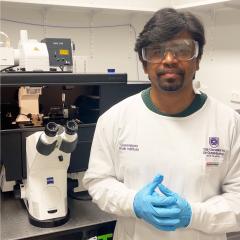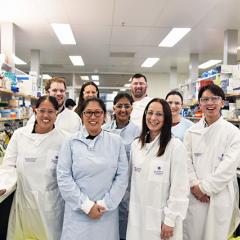State of the art equipment to be purchased with a recent UQ Major Equipment and Infrastructure Grant will increase the School’s research capacity and enhance its teaching and learning activities.
The new equipment will allow School researchers and PhD students to record not only the electrical activity of individual cells but also the activity of the whole network in which the cells are embedded.
Associate Professor Mark Bellingham said the new equipment would open up new research possibilities, particularly in the relatively new field of opto-genetics.
“Opto-genetics involves introducing light-responsive proteins into neurons by genetic engineering, so when they are stimulated with light, they will either excite or inhibit the individual cell,” he said.
“Blue light is used for the excitation of cells while yellow light is used for inhibition. The new equipment has a sophisticated light control source that will allow us to target any point in the microscope field to selectively manipulate the excitability of cells.
“With our current standard electrophysiology equipment, we are limited to recording one cell at a time and our options for stimulating that cell with light are relatively limited.
“With the new equipment we will be able to monitor the effects of targeted light stimulation on different areas of brain tissue, down to the single neuron level and we will also to do this in intact nervous systems of small organisms such as fruit flies or worms.
“This new equipment is extremely versatile, as the light source can be easily changed from high powered lasers for high intensity stimulation to normal light sources such as LEDs or fluorescent lamps.”
One of the aims of UQ Major Equipment and Infrastructure (MEI) grants is to ensure areas of recognised high quality research potential have access to support for development.
The new equipment will be used by Associate Professor Bellingham’s laboratory for research into the role of neural activity in driving neurodegenerative diseases such as MND, which have no known genetic cause.
“From laboratory tests using a MND mouse model, we have evidence that vulnerable neurons in the nervous system start to show excess levels of activity from a very early stage, soon after the animals are born,” he said.
“We want to use fibre optic technology to use yellow light to inhibit neurons in the laboratory mouse model, to see whether we can prevent this excess activity from taking place.
“We may also test the opposite hypothesis, to find out if stimulating excess activity in neurons with blue light can cause disease in a normal laboratory mouse model.”
The new equipment is expected to arrive in the next three or four months and will be accessible to all UQ researchers. Interest has already been shown by six SBMS laboratories and two laboratories within QBI.



